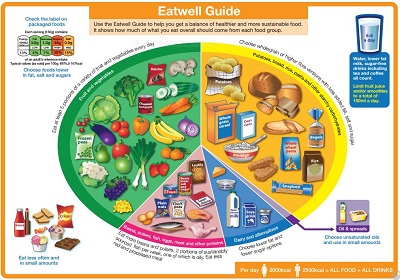“You are what you eat” is a well-worn phrase and there’s sound common sense in the principle that a healthy diet is the cornerstone of a healthy life.
The trouble is that advice on what is or isn’t good for you seems to change almost daily, with some claims counteracting others. To help make things simple and straightforward, Public Health England has produced a handy “Eatwell Guide”, setting out the basics of a healthy diet in a clear and easy-to-understand way.
 Central to it is the “Eatwell Plate” (pictured right) – a depiction of the types of food we should be eating and the proportions in which they should make up our regular diet. The plate is divided into sections, each sections showing the food groups which make up a healthy diet and the size of each section giving an indication of how much of each type we should eat.
Central to it is the “Eatwell Plate” (pictured right) – a depiction of the types of food we should be eating and the proportions in which they should make up our regular diet. The plate is divided into sections, each sections showing the food groups which make up a healthy diet and the size of each section giving an indication of how much of each type we should eat.
Adults and young people should aim to stick to a daily calorie limit, around 2,500 calories for men and 2,000 for women. This will vary depending on your lifestyle – active people, such as those doing manual jobs, will need more, while those who are less active and ‘burning fewer calories’ will need to take in less through food.
But whatever group you are in, it is important to stay hydrated by drinking regularly. The Eatwell Plate recommends six to eight glasses per day of water, lower-fat milk and sugar-free drinks including tea and coffee. Staying hydrated is particularly important for older people or those who are less active.
The biggest section of the Eatwell Plate is devoted to fruit and vegetables, with the recommendation that we should try to eat at least five 80g portions each day. They can be fresh, frozen, canned, dried or juiced, though fruit juice should be limited to a total of 150ml per day. Everyone will have their favourite fruit and veg, but you could also explore the fruit and veg aisle in the supermarket and look out for new things to try.
Almost as big, covering just over a third of the Eatwell Plate, is the section devoted to ‘starchy carbohydrates’ – foods such as potatoes, bread, rice, pasta and cereals. Some people think starchy food is fattening, but gram for gram it contains less than half the calories of fat. Try to choose higher-fibre and wholegrain varieties of these foods, such as wholegrain bread and cereals, wholewheat pasta, brown rice or simply leaving the skins on potatoes. Wholegrain foods contain more fibre, and often more nutrients, than ‘refined’ foods such as white bread.
The next largest section is devoted to foods which are high in protein, such as beans, pulses, fish, eggs and meat. Within this food group it is recommended to eat two portions of fish per week, one of which is ‘oily fish’. Red meat and processed meat should be limited, and try to use lean cuts of meat or cut off visible fat and drain most of the fat off mince once you’ve cooked it. Grilling meat and fish is better for you than frying it. ‘Processed meat’ includes things like sausages, bacon, cured meats and cooked meats.
Next on the Eatwell Palte is a small section for ‘dairy foods’, things like milk, cheese and yoghurts, or some of the many ‘dairy alternatives’ now available, like soya milk. These foods are a good source of protein, vitamins and calcium for strong bones, but some can be high in fat and saturated fat. If you can, choose lower-fat versions, or use the full-fat versions sparingly. In most cases, you won’t notice a big change in taste of texture with the lower fat alternatives, and you might actually prefer them.
Just a thin sliver of the Eatwell Plate is devoted to oils and spreads, such as cooking oil and margarine. Some fat is essential for a healthy diet, but most of us eat too much of it. Try to choose unsaturated fats that are usually from plant sources, such as vegetable oil or olive oil, and lower fat spreads instead of butter.
Not included on the Eatwell Plate are foods which are high in fat, salt or sugar, such as chocolates, cakes, crisps, biscuits, sugary soft drinks and ice cream. However, it’s also true that “a little of what you fancy does you good” – as long as you focus on the “little”! Use these foods as occasional treats and again, try to look for healthier options where they are available. The Eatwell Guide includes a helpful section on how to check the labelling on packaged foods and what warning signs to look out for.
● You can download both the Eatwell Plate graphic and the full 12-page Eatwell Guide and print them off for handy reference. For the Eatwell Plate click here, and for the Eatwell Guide, click here. Bon appetit!
